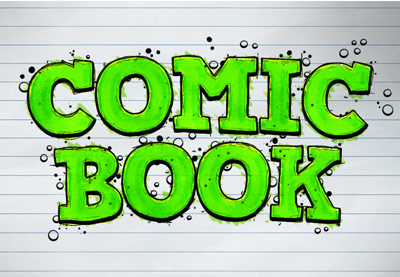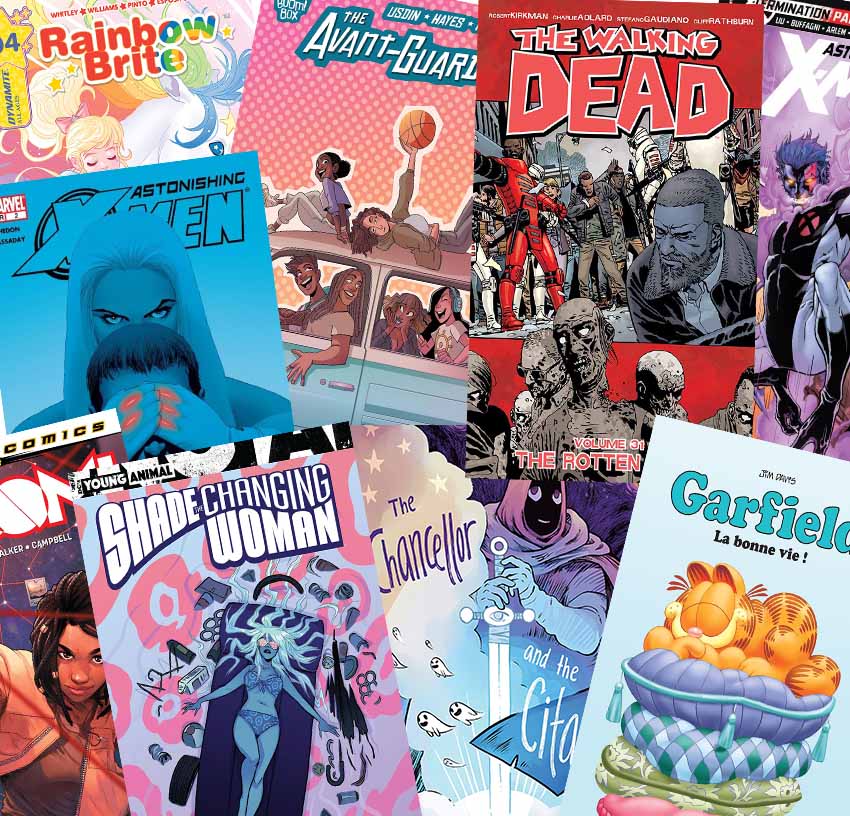
Truth be told, yes, you should judge a book by its cover, especially when it comes to comic book covers. Read this tutorial to learn some rules for designing a stand-out cover for your graphic novels.
Want to create a comic book covers to attract readers and entice people to buy your comic? Let me help you out. Think of comic book covers like Instagram posts… except with superheroes and people trying to save the world.
These graphic story covers are the first thing to catch a potential buyer’s eye and a reader’s interest. For that reason, you need to make sure the cover design is engaging and attention grabbing, portraying the heroes’ brand style and voice, and overall giving a clue to the story within.
There are many approaches to comic cover art. Follow me and let’s learn some necessary basics to designing a good comic cover that stands out from the rest.
And if you need some useful resources for making comic book effects quickly and easily, you can find them here:
1. The Elements of Making a Comic Cover
Before you start laying out your design, you should know which elements to include when making your comic cover. This will enable you to utilise the ‘artboard’ space correctly and to preview where the main artwork will be positioned. The basic elements to include on a comic cover are:
- Logo
- Title + Subtitle/Tagline
- Date of Publication
- Author
- Publisher
- Price
- Series # / Episode #
- Names of artists & designers
- Barcode
To set up the comic book cover template, you may need some graphic design skills to lay out these elements in a well-composed form. Once that’s assessed, you can start putting together your thoughts for the cover design. Just make sure to keep the title, series and episode numbers clearly displayed and readable once the artwork is laid in.
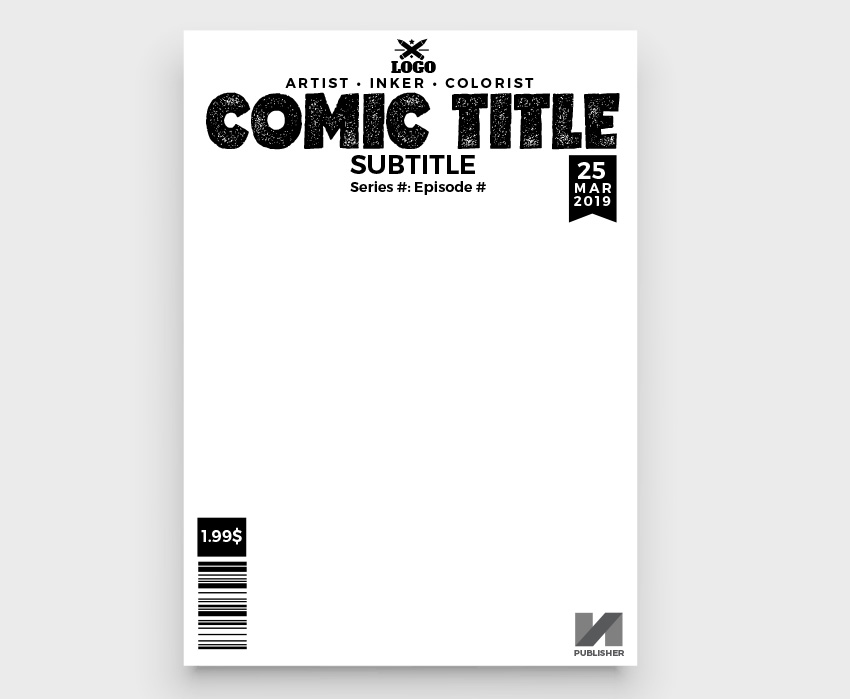
2. Brainstorm & Conceptualise
Step 1
If this is your first time creating a cover, it’s advisable to first look and get inspired by other comic covers in the market, so do your own research. Search online or visit comic stores to check the latest trends.
For example, if most comic books are colorful and full of art, you can choose to create a simple monotone cover design that will stand out from the crowd.
Think about the concept of your comic cover.
Try putting yourself in the place of the buyer, and ask yourself:
- What would make the cover interesting enough for readers to pick up the comic book?
- Does the cover portray the genre of the story?
- Does the cover illustration present a question of what the storyline is about?
- Is the cover an example of the artwork inside?
- Does the cover communicate the tone of the story?
The comic book illustration is the front face of the story. The main focus is on having the cover illustration reveal the content of the book. If anything, it should reveal a teaser illustration that intrigues customers to pick up and read what’s happening within the comic.
For example, if the comic is a family drama, depict a family scene in a critical moment as they are interacting with one another. If it’s about a superhero, show the superhero/heroine in a compromising or dangerous position. Make sure your primary character/s are on that cover!
Step 2
Plan the cover by sketching out a dummy.
To help you conceptualise, sketch out your ideas in thumbnail scale or create a dummy. This will help you work through your ideas and get the best image laid out properly.
Designing a comic book cover artwork is really a technique of composition, and there are a few guidelines to follow to deliver a captivating design, so let’s go through them next.
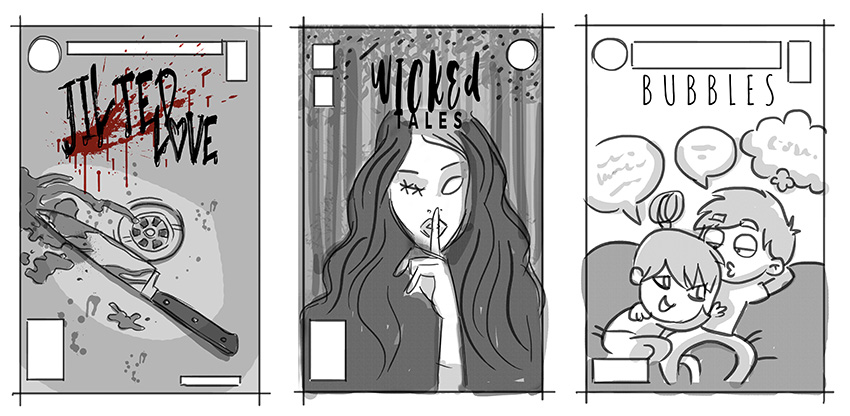
3. Plan the Comic Cover Content
Step 1
Brainstorm a catchy and fitting title.
Consider some words that might hook your audience in an instant. A title that perhaps reflects the character’s behaviour or emotional turmoil, action plot lines, battles, mystery, or perhaps a funny play on words. For example:
- Emotional titles like “Playful Rage” or “Risky Behaviour”
- Comeback titles like “Resurrection’ or “The Revival”
- Battle titles like “5 Armies” or “Bloodbath VI”
- Mysterious titles like ‘In the Lap of the Gods” or “Hush-Hush”
- Pun titles like “The Great Cat-sby” or “Positivi-tea”
The most common titles either use the main character name, are ‘action’ based, or have a mysterious tone.
Make sure that whichever title you choose, it connects with the cover art and offers readers a feel for what the story will be like on the inside. So if it’s a romantic comic with the title “Love Lounge”, then it should probably reflect a love scene or seductive mood on the cover.
Keep in mind that the font or lettering style of the title must fit the mood of the story. So don’t use a bubble-shaped title if your story is under a horror genre—instead, go for a distressed look.
Design Tips:
- Avoid use of bevels or drop shadow effects. The title should stand out alone.
- Don’t load the title design with too much color. Keep it clean and simple.
- Choose readable fonts. Avoid the use of fancy fonts for the title, author, artist, episode #, and series #.
- Bolder and bigger is not better. Keep your title lettering spaced and not crammed in.

Step 2
Choose which characters to show and how many.
Which characters would you like to place on the comic book cover? Only one
main character, two main characters, a villain, a group of people, etc.? It’s important to showcase the stars of your comics on the cover, whether it’s the villain or the hero.
For instance, showcasing a single character has a more striking appearance than a group of characters. It tends to strengthen the presence of our star character and makes it easier for fans to recognise what and who
the comic is about. On top of that, single-character covers tend to give a sense of uniqueness, mystery, and the unexpected. It’s preferable to avoid too many characters on a cover, as it may look overcrowded and messy.
Design Tip:
- Always remember, when positioning characters, that the human eye usually moves from left to right, onto the middle of the page and down to the bottom.
- Keep away from offensive, sexist, and biased content.
- Make sure the characters on the cover have a purpose in the scene.
- Don’t overcrowd the design unless you wish to show magnitude.
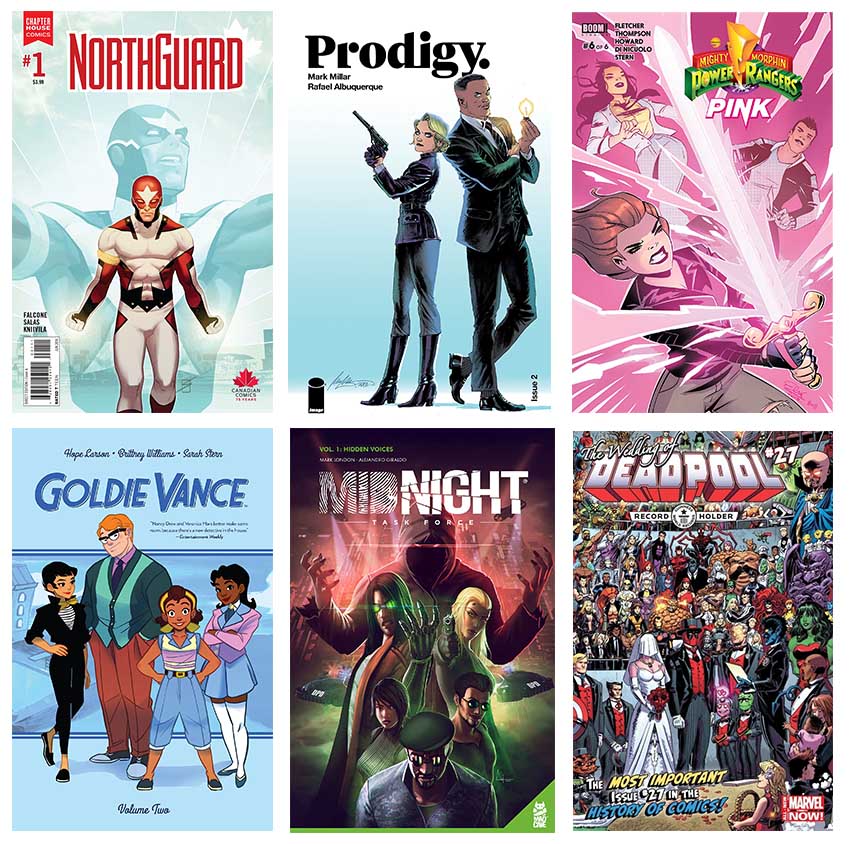
Step 3
Distribute and position characters artistically.
Comic covers often show characters performing all kinds of motions, like flying, swinging, running, jumping, falling, etc. There are several ways you can showcase your characters on the comic cover, but let’s learn how to do so in a more charismatic way.
- A popular layout is the ‘villain vs. hero‘ face-off. Here, the characters are placed in the classic ‘VS” pose, opposite each other.
- Eye contact is when the character stares directly into the reader’s eyes. This can create a focus of interest and the unknown.
- Oversizing villains in the background is very dramatic and can create an ill-fated scene with an ominous tone.
- Scaling is used when you wish to show the magnitude of a ‘battle’ field. A large number of characters are presented at a smaller scale to give a sense of grandeur to the scene. This also helps to integrate more of the setting or environment of the storyline.
- Pivotal Point is when a crucial part of the story is presented, for instance the star character stuck in an extraordinary situation. In this case, make sure the cover is centred on the ‘hero’ in that pivotal point of the story. The artwork should reflect a ‘hint’ of the story within, yet not reveal everything that’s going on.

4. How to Incorporate Color Into the Cover Design
The colors you choose for your comic book cover can pique interest as well as drawing attention to the design. When selecting your color palette, make sure it reflects the mood you want to create.
Dark colors convey a sense of evil, suspense, wisdom, or authority. Bright & Lustrous colors convey friendship, dynamism, confidence, and ambition. Pastels are suitable for innocence, romantic covers, and lighter subject matters.
The color tone you choose for your comic should be unique,
eye-catching, and always remain consistent to the comic, or you will confuse readers. It works best when you have a branded color scheme so that the reader can distinguish and recognise the comic book amongst other novels.
- Bright covers are the first thing that readers may notice. However, if you find there are many bright-covered comics out there, then to stand out, choose to make a darker comic book cover.
-
Limited color schemes like monochrome tones,
contrasting colours, or just the use of a bold color or shapes can make up very intriguing comic covers. By using monochrome or bold colors, you can make the cover visible from a distance. Contrast color is also a good method to follow, but it doesn’t create a hierarchy of focus points if you are trying to zero in on elements. Contrast colors basically increase visibility and ensure that the cover stands out on the shelf. - The use of Negative Space or lack of color (made up of a lot of white), is a brilliant composition technique that allows you to draw attention to your subject and creates an air of mystery.
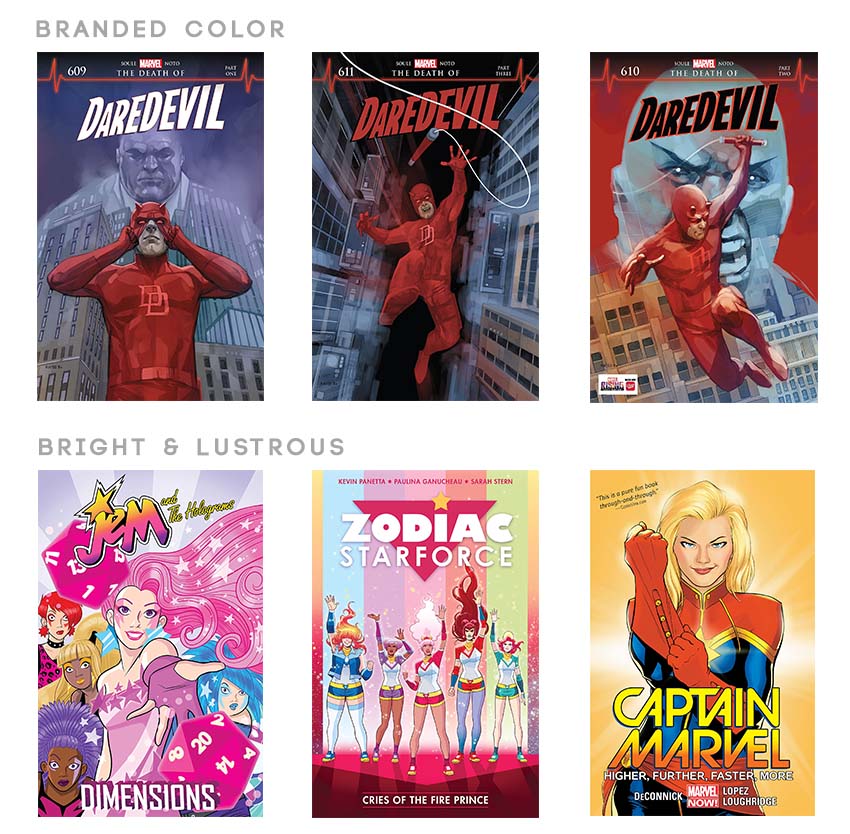
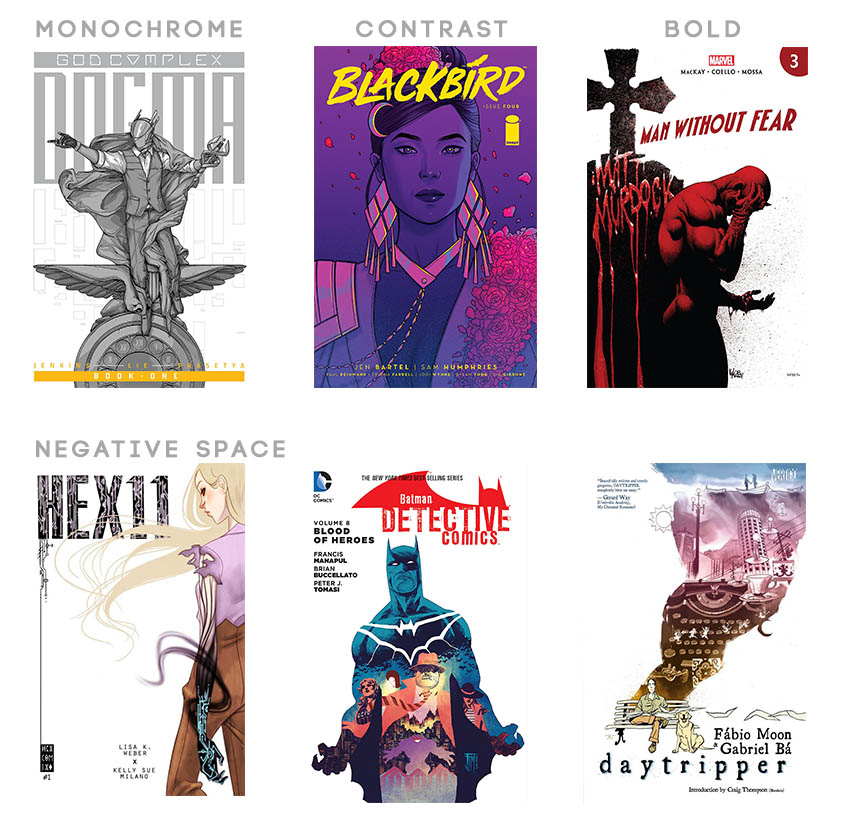
5. How to Compose Characters on the Comic Cover
Composition is an important factor when designing the cover. It’s how artistic elements are arranged in terms of line work, texture, color, form, space, and so forth to create a
balanced image. A nicely composed cover may be achieved by using these compositional tricks:
- Amusing angles: Low angle, overhead, flipped, twisted, etc.
- Askew compositions that place the subject away from the center of the page, adding a sense of motion and interest to the scene.
- Illusion of movement, motion, or action. To convey motion, line drawing is applied: speed lines, motion trails, or draw debris or sweat flying….
- Graphic design elements: Geometric or organic shapes, texture, borders, or frames
- Text Integration: Typography, letters, and lettering are an added value and create dynamic compositions.
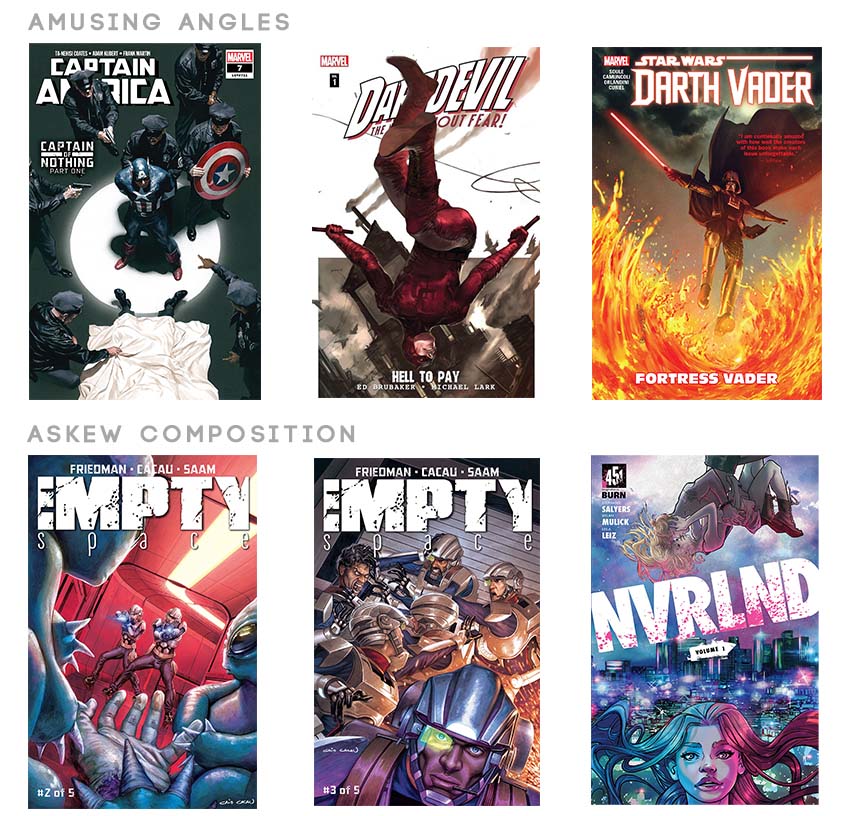
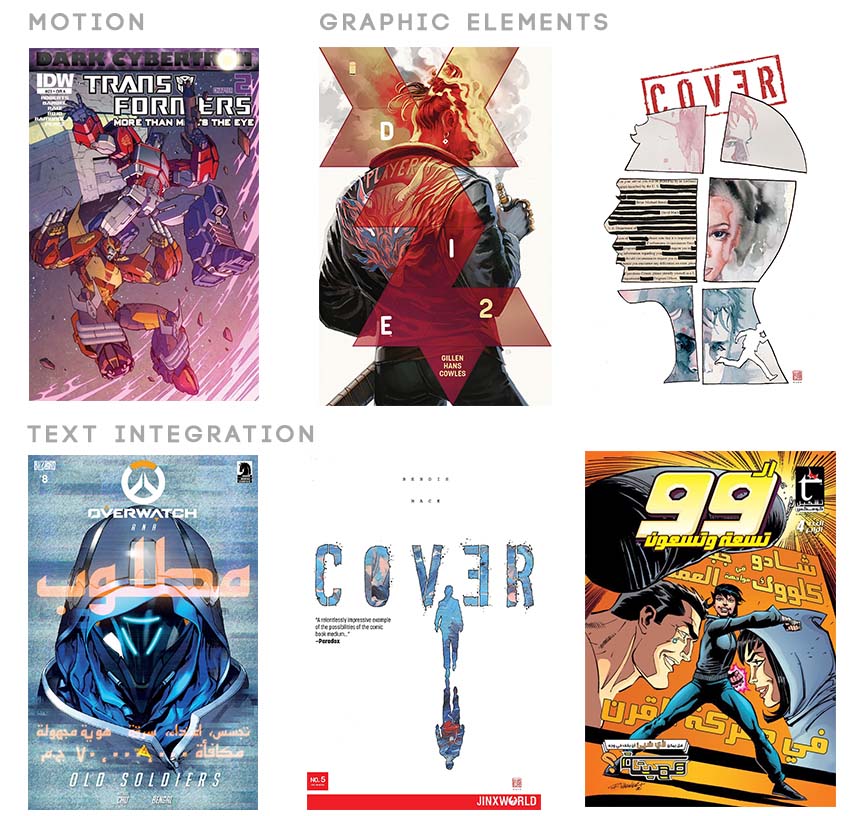
6. Creativity
Be creative.
Build a mood board, doodle, and play with ideas or word games to generate ideas. Get back to the basics of things and try to spark your imagination, as comic covers play an essential part in comic book sales. Keep in mind that you want to give purpose to your images and maintain artwork that is balanced, clean, and true to the content of the story.
Try to push the forms and angles of your design and create signature looks by adding your own personal style and flavor to the design. That will get you noticed on the comic shelves and amongst the fans.
Creating a comic cover takes a lot of work. Get feedback from friends and family. Ask if the comic book looks interesting enough. Take note of any minor design issues that you may have overlooked, and gather their feedback and suggestions on how you can make the cover look more appealing.
Keep yourself updated on the latest comic trends, and remember that these are just guidelines, and there are always exceptions to these suggestions.
Congratulations! You’re Ready!
I hope you were able to learn something new. Now you know the guidelines to creating a good comic book cover, it will steer you in the direction of creating eye-catching designs.
Always remember to have fun and keep your personal style!
If you enjoyed this article and are looking for more comic content, why not check out the following roundups:
 CareersSo You Want to Be a Comic Artist?
CareersSo You Want to Be a Comic Artist? IllustrationDynamic Comic Book Illustration in Adobe Illustrator Cs6
IllustrationDynamic Comic Book Illustration in Adobe Illustrator Cs6 Text EffectsHow to Create a Comic-Book Ink Text Effect in Adobe Photoshop
Text EffectsHow to Create a Comic-Book Ink Text Effect in Adobe Photoshop Photo Manipulation50+ Insane Comic-Book Style Photoshop Effects and Cartoon Filters
Photo Manipulation50+ Insane Comic-Book Style Photoshop Effects and Cartoon Filters Photo EffectsHow to Turn a Photo Into Comic Book Art in Adobe Photoshop
Photo EffectsHow to Turn a Photo Into Comic Book Art in Adobe Photoshop




